Background on bTB
Cattle TB or Bovine tuberculosis (caused by Mycobacterium Bovis) is one of the most serious problems currently facing dairy farmers and cattle owners in Great Britain. It is wreaking havoc in the industry, undermining the sustainability of the sector and is the cause of huge animal welfare problems. bTB costs farmers and indirectly, consumers millions of pounds a year through loss of infected livestock and control of the disease.
There have been significant recent reports into bTB including the publication of the Independent Scientific Group on Cattle TB (ISG)’s final report in 2007. There are many unknowns about the disease including uncertainty around the transmission of the disease. Defra have stated the main wildlife reservoir for bTB in Britain is badgers. These animals suffer greatly through the disease with symptoms such as loss of appetite, weakness and weight loss, though death is not common and therefore they become a good vector. As the disease sets in their weakness causes them to travel less to reach food, using cattle feed stores and drinking troughs to feed themselves and creating badger to cattle spread.
Research into the disease and movements through the Cattle Tracing System archive have shown evidence that the disease is also passed from cattle to cattle, particularly those from areas where bTB is reported, this consistently outperforms environmental, topographic and other anthropogenic variables as the main predictor of disease occurrence.
The Welsh Assembly has backed a £27million 3-year bTB eradication plan that includes a limited badger cull in disease hotspots in Wales. There was an all-party agreement that a holistic approach should be taken, and many industry bodies have suggested this is the way forward for Defra in England.
In order to significantly reduce the incidence of cattle TB, a multi-faceted approach has been suggested by the Efra committee as the best way of targeting the disease in cattle and wildlife with budgeting for any such policy reflecting a spend to save approach. Cattle-based measures must be strengthened. The introduction of post-movement testing in respect of animals moving from high to low risk areas should be considered, along with a more strategically directed use of the gamma interferon test in both routine and pre-movement testing. However this could lead to increased numbers of animals slaughtered as previously undetected infected cattle are identified.
It is important that research continues to fill the gaps in the scientific knowledge on bTB and Defra must ensure funding is found to reduce the risk of disease spiralling out of control and effecting England’s export market. Culling of badgers should only ever be considered in areas of the country where there is a high risk of cattle TB. Culling to be carried out competently and efficiently; be coordinated; cover as large an area as possible (265km²); be sustained for at least four years; and be in areas which have hard or soft boundaries. Public opinion and concerns of badger welfare groups should also be considered by Defra when drawing up a framework on badger culling.
